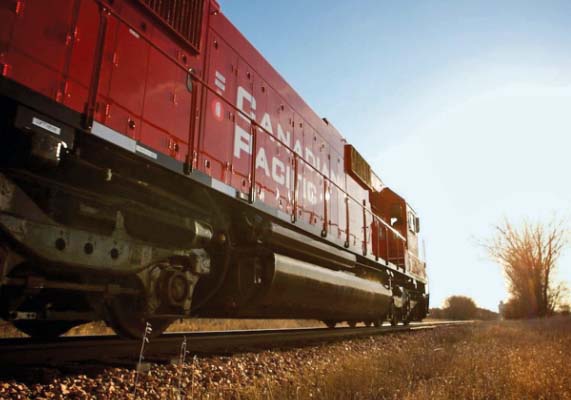
Toronto Ontario - Canadian Pacific Railway (CP) plans to improve its reliability and movement of Canadian grain with significant capital
investment in new rail cars (contingent on Parliament passing the original version of bill C-49), replacement of old equipment, and network changes that
include an 8,500 foot loop system at grain elevators, said one executive during the Canadian Global Crops Symposium.
A combination of new rail cars and an 8,500 foot dedicated train model would grow the volume of grain moved per train by 35 percent, said Murray Hamilton,
assistant vice-president of grain and fertilizer sales and marketing team at CP.
"It's going to change the landscape of Canadian grain and origination and movement once this whole program is put through and enabled," he
said.
"I think it really does drive reliability, more consistency, and puts a better product out on the marketplace that anyone who is shipping grain in Canada
can be proud of."
Hamilton addressed the issue of rail reliability during the symposium in Toronto at the end of March against the backdrop of a rail system that is experiencing
significant delays in moving grain.
In mid-March, the Canadian government expressed its concerns over the delays with the CP and CN railroads and asked them to clarify how they plan to address
the backlog.
Hamilton stressed three messages during his talk:
- Despite what might be the common belief, grain is critically important to CP;
- The supply chain must be considered from a macro perspective, from farm gate through to vessel;
- CP is stepping up investments in products and services to drive more accountability and reliability in its movement of Canadian grain.
In 2017, grain from Canada and the United States represented about 24 percent of revenues in total for CP.
Canadian grain accounted for about $1.04 billion of the revenue and U.S. grain for about $500 million.
"Grain is a key commodity for CP," Hamilton said.
"With the new products and services we're going to put in the marketplace, I would like to see that grain revenue number grow bigger than it is
today. Grain is our single largest commodity at CP that we move. As a result just because of the size, it does consume a fair amount of resources from a
people, locomotive, and infrastructure standpoint."
Rail Delays
Cold weather, heavy snowfall, and a large 2017 harvest along with increased demand from intermodal freight shipments and fracking sand from Wisconsin have been
causing rail capacity issues since September, according to a report from the U.S. Department of Agriculture's Foreign Agricultural Service (FAS).
Shipments of oilseeds, grains, and pulses are backlogged out of Thunder Bay, Vancouver, and Prince Rupert.
Producers were told grain that was expected to ship months ago may not move until April, the report said.
Total grain volume at the three main ports are 5.5 percent behind last year, but on par with the five-year average.
Canadian National's (CN) overall car order fulfilment rate dropped to 56 percent in fall 2017, according to the Ag Transport Coalition.
CN and CP combined provided only 38 percent of the railcars ordered by grain shippers in the week of 12 Feb 2018.
CP delivered 66 percent of its orders and CN delivered 17 percent.
The Canadian government has introduced the Transportation Modernization Act (Bill C-49) to provide long-term solutions to the transportation issues, but it's
still making its way through Parliament.
This is the second time in five years that the railroads have struggled to move the Canadian harvest.
In 2013-2014, the perfect storm of a bumper harvest and an extremely snowy and cold winter caused significant delays and led to a loss of between $6 million
and $8.5 million for Canadian farmers.
In response, the Canadian government set minimum grain movements for a set period of time and required monthly reporting on weekly rail car cycles and the
status of rail cars used to move grain.
CP's Response
Since 2012, CP's operating performance has been improving, Hamilton said.
Train speed is up 23 percent while terminal dwell, the amount of time assets sit idle as they are moving from origin to destination, was down 7
percent.
Fuel productivity improved 8 percent due to better technology in the locomotives along with better management.
Train lengths are also up 10 percent.
"That's a big opportunity looming for us, particularly in Canadian grain, as we think about longer trains moving more grain," Hamilton
said.
CP has one of the strongest origination footprints for grain in North America, he said, with customers operating 78 high throughput elevators (112 train cars
or greater) and five 8,500 foot loop track elevators with another two coming online by the end of summer.
With the current loop tracks, trains are 112 cars long, with an 8,500 foot loop, trains could grow to 134 cars.
"That represents a 20 percent increase of grain per train," Hamilton said.
"We would be moving less trains, and less movement in the supply chain, by extension, creates more reliability."
Taking it a step further, with new larger capacity rail cars, those trains could grow to 148 cars, for a 35 percent increase in the amount of grain moved per
train.
This works because the new railcars are shorter than the current ones, so trains won't exceed 8,500 feet even with the additional 14 railcars.
"For every three trains we move today, we'll move two trains," Hamilton said.
"So, for the grain shipper, the number of trains and movements they need to make to fill a vessel starts to compress and shrink."
CP plans to spend between $1.3 billion and $1.5 billion on capital expenditures in 2018.
A significant portion of that, about $500 million, is tied to passage of C49.
If passed by the government, the law would trigger investment in new hopper cars to replace all of the existing government hopper cars, Hamilton
said.
The new cars would be 56 feet long, high capacity cars, creating a fleet to move grain in Canada and the United States.
Another benefit of the 8,500 foot model is that the power stays with the train.
Under the system, the CP crew would move the train off the main rail line and onto the elevator's loop.
CP employees would get off the train and get their required rest time, while elevator employees took care of loading the grain.
When the train is ready 12 to 16 hours later, the same crew can get back on the train and take it to its final destination.
All of this activity takes place clear of the main track, so other trains passing by won't have to stop and wait for the grain train to finish.
"The amount of savings in terms of cycle time that we think will get developed through this model could be up to two or three days," Hamilton
said.
"In a 10 to 14 day cycle, that's a significant improvement."
There's no doubt railroads have a critical role to play in the logistical management of grain from elevator to port terminal.
At any step along the way, from farmer to elevator, to railroad to port, there can be variables that impact movement of grain.
"It has to be, and needs to be, a very integrated supply chain," Hamilton said.
"The tighter we work in terms of visibility, information, and communication, the more successful we are in moving grain to market."
The variability in the size of harvest from year to year makes it difficult to plan ahead on what resources the railroad will need to move the
crop.
Up until the end of October, the grain industry was saying the harvest would be around 64 million to 66 million tonnes, but it actually came in at around 71
million tonnes.
That's a 10 percent increase in production the railroads have to provide resources for.
"In our business, getting crews and adding power doesn't happen overnight," Hamilton said.
"The better visibility we get to where were going to end up in total capacity helps make our job easier and creates greater
reliability."
Susan Reidy.
OKthePK Joint Bar Editor: Article abridged - data on the Port of Vancouver operations removed.
under the provisions in
Section 29 of the Canadian
Copyright Modernization Act.

